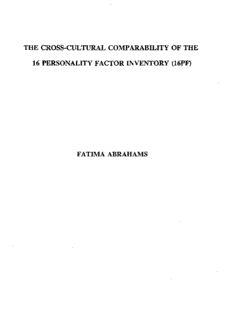
(16pf) fatima abrahams PDF
Preview (16pf) fatima abrahams
THE CROSS-CULTURAL COMPARABILITY OF THE 16 PERSONALITY FACTOR INVENTORY (16PF) FATIMA ABRAHAMS THE CROSS-CULTURAL COMPARABILITY OF TIIE 16 PERSONALITY FACTOR INVENTORY (16PF) by FATIMA ABRAHAMS submitted in accordance with the requirements for the degree of DOCTOR OF COMMERCE in the subject INDUSTRIAL PSYCHOLOGY at the UNIVERSITY OF SOUTH AFRICA PROMOTER: PROF K F MAUER 30 NOVEMBER 1996 IBIS IBESIS IS DEDICATED TO MY PARENTS, ACHMAT AND WARALDIA GYDIEN, MY HUSBAND, RAMZIE AND MY DAUGHTERS, ZAREEN AND MISHKAH. UN ISA BIBUOTEEK I LIBRARY , rn~d-04- 1 Class Klas .. 155. 283 ABRA Ace es Aanwi1 ...... . llHHlmHllll 0001698820 Student number: 3004-475-8 I declare that The cross-cultural comparability of the 16 Personality Factor Inventory (16PF) is my own work and all that I have used or quoted have been indicated and acknowledged by means of complete references. SIGNATURE DATE (MRS) F ABRAHAMS ACKNOWLEDGEMENTS All praises are due to the Creator who granted me the ability to tackle and complete this thesis. I would also like to thank all the people who supported me throughout the process, particularly: Prof. K F Mauer, my supervisor, for his suggestions and inputs about the thesis in general, his critical comments of the draft chapters, and his constant willingness to support me throughout the entire process. Prof. Micheal Muller and Ms. Evelyn Muller for their advice and help with conducting the statistical analysis. My brother Ziyaad, for his continual support and for acting as my research assistant, who spent many hours coding and punching the data. The staff of the Psychology and/or Industrial Psychology Departments at the University of Durban-Westville, University of Pretoria, and University of Natal who so willingly spent time helping me with the administration of the test. All the students who participated in the study, particularly my honours students of 1996. The staff of the department of Industrial Psychology, UWC, for their constant encouragement and support. My parents, Achmat and Waraldia Gydien who made many sacrifices throughout their lives to give me an education and who supported me emotionally and physically whilst busy with this thesis. My husband Ramzie, whose support and encouragement was invaluable during this period, and who made valuable comments about my research. My daughters, Mishkah and Zareen, who inspire me continually and who love me unconditionally. And last, but not least, my brothers Sedick and Riad, who supported and encouraged me continually, even though we argued over many issues over the years, as sibling often do. Finally, the financial assistance of the Centre for Science Development towards this research is acknowledged. Opinions expressed in this thesis and conclusions arrived at, are those of the author and are not necessarily to be attributed to the Centre for Science Development. TABLE OF CONTENTS Page LIST OF TABLES viii LIST OF FIGURES XlV SUMMARY xvi CHAPI'ER 1 INTRODUCTION 1 1.1 Background 1 1.2 Importance of Research 5 1.3 Aims 8 1.4 Conclusion 9 CHAPI'ER 2 CROSS-CULTURAL PSYCHOWGY 10 2.1 Introduction 10 2.2 Cross-cultural Psychology 10 2.3 Goals of cross-cultural psychology 13 2.4 Relationships with other disciplines 15 2.4.1 Historical development 16 2.4.2 Cross-cultural psychology in South Africa 20 2.4.3 Academic interest in cross-cultural psychology 25 2.5 Etic-Emic Distinction 27 2.6 Ethnocentrism of psychology 29 11 2.7 Culture and ethnicity 35 2.7.1 Culture 35 2.7.2 Ethnicity 37 2.8 Conclusion 39 CHAPTER 3 COMPARABILITY OF PERSONALITY TESTS 40 3.1 Introduction 40 3.2 Comparability 42 3.2.1 The logic of comparability 42 3.2.2 Defining comparability 44 3.3 Bias 48 3.3.1 Bias in predictive validity 49 3.3.2 Bias in construct validity 51 3.3.3 Bias in content validity 52 3.4 Relationship between comparability and bias 56 3.5 Research on the cross-cultural comparability of personality tests 57 3.5.1 Cross-cultural research on the 16PF 64 3.5.2 Cross-cultural research on personality tests in South Africa 69 3.6 Conclusion 71 Ill CHAYfER 4 CATTELL'S FACTOR THEORY 72 4.1 Introduction 72 4.2 Trait Theorists 73 4.2.1 Allport 73 4.2.2 Guilford 75 4.2.3 Eysenck 76 4.3 Cattell' s Factor Theory 78 4.3.1 Definition of Personality 79 4.3.2 Structure of Personalty 82 4.3.2.1 Classification of traits 82 4.3.2.2 Dynamic structure 87 4.3.2.3 The dynamic lattice 91 4.3.2.4 Conflict and the specification equation 92 4.3.3 Research methodology 93 4.3.3.1 Sources of data 93 4.3.3.2 Basic techniques in factor analytic methods 97 4.3.4 Stages of Personality Development 100 4.3.5 Heredity-Environment Research and Learning 103 4.3.6 Evaluation of Cattell's theory 105 4.4 Conclusion 109 iv CHAPTERS STATEMENT OF PROBLEM AND HYPOTHESIS 110 5.1 Introduction 110 5.2 Hypotheses 112 CHAPTER 6 RESEARCH DESIGN 118 6.1 Sample 118 6.2 Measuring Instruments 128 6.2.1 The 16 Personality Factor Questionnaire (16PF) 128 6.2.1.1 The uses of the 16PF 132 6.2.1.2 Interpreting the 16PF 133 6.2.1.2.1 First-order factors 134 6.2.1.2.2 Second-order factors 165 6.2.1.2.3 Third-order factors 169 6.2.1.3 Evaluation of the 16PF 170 6.2.1.4 The 16PF in South Africa 175 6.2.1.4.1 The 16 Personality factor Questionnaire, South African 1992 version (16PF SA92) 177 6.2.2 Biographical Questionnaire 183 6.3 Procedure 187 6.4 Methods and techniques 187 6.5 Conclusion 188
Description: